|
|
|
Sort Order |
|
|
|
Items / Page
|
|
|
|
|
|
|
| Srl | Item |
| 1 |
ID:
189552
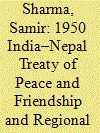

|
|
|
|
|
| Summary/Abstract |
Regional demands for statehood in India have had an aspiration towards a ‘nationalisation’ of their issues in the hopes of accommodation. In the case of the Gorkhaland movement for separate statehood in northern West Bengal, the competition among regional forces to occupy and share a ‘national political space’ from the ‘margins’ has fuelled the increasing employment of debates regarding international treaty obligations. While there are numerous factors that are the causes of regional political mobilisation, the demand for the abrogation of Article VII of the India–Nepal Treaty of Peace and Friendship (1950) has nevertheless remained as one of its central themes. This symbolises an accentuation in the anxieties of citizenship and belonging to the nation. Examining these amid the important issues relating to unsuccessful invocations from Nepal for a Brihat Nepal (Greater Nepal), and the constitution of the Eminent Persons Group (EPG) for India–Nepal relations, the article concludes that there will not be any radical change in the status quo of India’s international treaty obligations with Nepal despite repeated demands by regional actors in India. This is indicated in an elusive ‘permanent political solution’ declared by the ruling party in India as a response to the regional political mobilisation that will possibly depart from the debates that invoke and demand transformations to India’s treaty obligations with Nepal.
|
|
|
|
|
|
|
|
|
|
|
|
|
|
|
|
| 2 |
ID:
083435
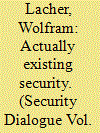

|
|
|
|
|
| Publication |
2008.
|
| Summary/Abstract |
The transformation of Saharan populations into an object of global security is analysed as a specific instance of security's expansion globally, as well as of its merger with development, understood as a side-effect of the former. It is shown that the search for threats in the Sahara, and the establishment of surveillance apparatuses, is a precondition for the detection and discursive production of these threats. Security, through its production of knowledge, manages to objectify what had hitherto constituted a borderland of knowledge and government. The securitization of the Sahara and its populations creates a field of intervention for diverse agents of security and development. However, it does so not as part of a coherent global regime of control, but on its own specific and random terms, within a political economy of danger that is the product of discursive and material struggles. The securitization of the Sahara, it is argued, should be seen as actually existing security - that is, a complex of security practices serving diverse interests, with contradictory and open-ended outcomes
|
|
|
|
|
|
|
|
|
|
|
|
|
|
|
|
| 3 |
ID:
121987
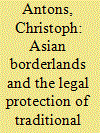

|
|
|
|
|
| Publication |
2013.
|
| Summary/Abstract |
Traditional knowledge related to biodiversity, agriculture, medicine and artistic expressions has recently attracted much interest amongst policy makers, legal academics and social scientists. Several United Nations organizations, such as the World Intellectual Property Organization (WIPO) and the Convention on Biological Diversity under the United Nations Environmental Programme (UNEP), have been working on international models for the protection of such knowledge held by local and indigenous communities. Relevant national, regional or provincial level legislation comes in the form of intellectual property laws and laws related to health, heritage or environmental protection. In practice, however, it has proven difficult to agree on definitions of the subject matter, to delineate local communities and territories holding the knowledge, and to clearly identify the subjects and beneficiaries of the protection. In fact, claims to 'cultural property' and heritage have led to conflicts and tensions between communities, regions and nations. This paper will use Southeast Asian examples and case studies to show the importance of concepts such as Zomia, 'regions of refuge' and mandala as well as 'borderlands' studies to avoid essentialized notions of communities and cultures in order to develop a nuanced understanding of the difficulties for national and international lawmaking in this field. It will also develop a few suggestions on how conflicts and tensions could be avoided or ameliorated.
|
|
|
|
|
|
|
|
|
|
|
|
|
|
|
|
| 4 |
ID:
114552
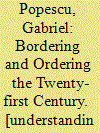

|
|
|
|
|
| Publication |
Lanham, Rowman & Littlefield Publishers, Inc., 2012.
|
| Description |
xi, 183p.Pbk
|
| Standard Number |
9780742556225
|
|
|
|
|
|
|
|
|
|
|
|
Copies: C:1/I:0,R:0,Q:0
Circulation
| Accession# | Call# | Current Location | Status | Policy | Location |
| 056794 | 320.12/POP 056794 | Main | On Shelf | General | |
|
|
|
|
| 5 |
ID:
072726
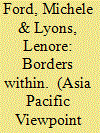

|
|
|
|
|
| Publication |
2006.
|
| Summary/Abstract |
The border studies literature makes a strong case against claims for unfettered transnationalism and 'borderlessness' in our 'globalising world'. However, its focus on movement across borders means that it fails to address bordering practices that occur within the nation-state as a result of transnational activity. In this paper, we extend Cunningham and Heyman's concepts 'enclosure' and 'mobility' to confront the different layers of bordering (both physical and non-physical) that have occurred in Indonesia's Riau Islands since they became part of the Indonesia-Malaysia-Singapore Growth Triangle.
|
|
|
|
|
|
|
|
|
|
|
|
|
|
|
|
| 6 |
ID:
103725
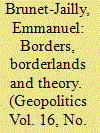

|
|
|
| 7 |
ID:
157612
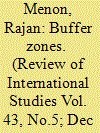

|
|
|
|
|
| Summary/Abstract |
Amidst calls for containing an assertive Russia, politicians and pundits have been debating whether Ukraine should serve as a ‘buffer zone’ between the Russian and Western spheres of influence. These debates provide an opportunity to revisit the long and varied history of major powers’ efforts to manage buffer zones. We draw on this history to learn the conditions under which buffer zones succeed or fail to stabilise regions, how buffers are most successfully managed, and when alternative arrangements for borderlands work better.
|
|
|
|
|
|
|
|
|
|
|
|
|
|
|
|
| 8 |
ID:
152969
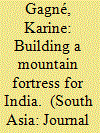

|
|
|
|
|
| Summary/Abstract |
This article examines the relationship between affect and the state in post-colonial India, foregrounding sympathy as a feeling that arises from the embodied encounters and interactions between the state and a local population through state-building in the Himalayas. It establishes the emergence of sympathy in the materiality of the Himalayas and in the historical conjuncture of the passage to Indian nationhood in Ladakh, which was marked by the mobilisation of the local population in the defence of the territory of India amid the first Indo-Pakistani war (1947–48). This article argues that sympathy, in leading the state to reimagine the population of Ladakh, is integral to the reconfiguration of the region into a border area and to the rethinking of the sovereignty of the Indian state at its Himalayan frontier.
|
|
|
|
|
|
|
|
|
|
|
|
|
|
|
|
| 9 |
ID:
103315
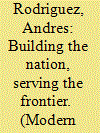

|
|
|
|
|
| Publication |
2011.
|
| Summary/Abstract |
The wartime period between 1937 and 1945 provided an exceptional opportunity for the Guomindang state to experiment with a wide array of schemes that sought to further its nation-state project in the borderland regions of China. Under the rubric of 'frontier reconstruction' (bianjiang jianshe) it devised a series of plans that encompassed both the economic and cultural transformations of these regions. This paper discusses a particular scheme devised by Chinese anthropologist, Li Anzhai (1900-1985), during his stay at the Tibetan Buddhist monastery of Labrang where he sought to transform borderland societies into a modern Chinese citizenry. A key aspect to his strategy was the mobilization of youth where trained cadres and students performed what became known as 'frontier service' (bianjiang fuwu) establishing a dialogue with the community's own particular demands by means of building schools, hospitals and agricultural projects. This paper argues that the notion of 'frontier service' and the 'cultural reconstruction' project propounded by Li not only sought to modernize and unify China around a distinct multicultural identity, it was also an important mobilizing force amongst sectors of wartime youth which arguably introduced young Han Chinese to a region which they had hitherto only imagined in the pre-war period.
|
|
|
|
|
|
|
|
|
|
|
|
|
|
|
|
| 10 |
ID:
112143
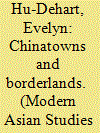

|
|
|
|
|
| Publication |
2012.
|
| Summary/Abstract |
This paper explores two dynamic places and spaces in the Americas, destination of several Asian diasporas-the Chinese, Japanese, and South Asian-as contact and exchange zones. One would be the ethnic enclaves commonly called 'Chinatowns', which stretch over time from the early sixteenth century to the present, and over space from Manila in the Spanish empire across the Pacific to all over the Americas. These Chinatowns, imagined and real and riddled with stereotypes, are well-known tropes on the American landscapes, and need no further preliminary introduction; they are also firmly located within fixed national (or colonial) entities.
The second space has not been historically associated with Asian diasporas in the Americas, although well known for different reasons. Here I refer to 'borderlands', the overlapping space between, over, and above two political national boundaries or borders, in particular the US-Mexican and US-Canadian borderlands, both, coincidentally, clearly marked and delineated by the mid-nineteenth century (1848 and 1846 respectively). Furthermore, as these two transnational/transborder regions are also trans-Pacific, their recognition as an integral part of Asian diasporas is belated and overdue. To make the case further, the study of Asians in the Americas has revealed that Asian migrants, labour, and capital have been historically drawn to these borderlands because they represent dynamic zones of economic development, first in the heyday of maturing American capitalism at the turn of the twentieth century, and again in the glaring eye of current late-capitalist globalization. In other words, Asians have amassed on both sides of these borders for over 100 years, where they have become adept at multiple border crossings, both trans-Pacific and transnational.
|
|
|
|
|
|
|
|
|
|
|
|
|
|
|
|
| 11 |
ID:
169998
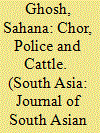

|
|
|
|
|
| Summary/Abstract |
India’s border with Bangladesh figures in the Indian national imagination as a unifying construct for multiple anxieties from illegal immigration to cattle smuggling, thus garnering public support for increased border security. What does a view from the lived and messy realities of the borderlands offer when we shift our focus from the fetish of the borderline as a political and religious marker of difference? This essay tracks the binary of legal–illegal through which cattle in the borderlands are framed, showing how bovines move across different terrains of the agrarian, the sacrificial and everyday cross-border trade in the borderlands and so resist this binary.
|
|
|
|
|
|
|
|
|
|
|
|
|
|
|
|
| 12 |
ID:
156825
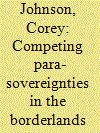

|
|
|
|
|
| Summary/Abstract |
This article is broadly concerned with how we conceptualise the geography of the tensions between the nominally stable orders of the modern state system against the turbulence of the past few decades in relation to that order, especially in the realm of border controls. Specifically, it considers the rescaling and relocation of border enforcement in the European Union in relation to state sovereignty. The article argues that existing “soft” conceptualisations of the EU’s relationship to sovereignty and bordering—“shared,” “joint,” “multi-level,” “consociational”—are inadequate to understand the transformations of exercises of sovereign power in European borderlands. Instead, we are witnessing the emergence of competing para-sovereignties acting within the same spaces, with both traditional states and the incipient state-like EU fulfilling particular bit roles in realms that were traditionally viewed as the exclusive responsibilities of modern, sovereign, territorial states. This dynamic is made visible in recent years in observing individual humans negotiate and subvert the fluid political geographies of European border space. Examples are taken from the activities of the EU border agency Frontex in southeastern Europe.
|
|
|
|
|
|
|
|
|
|
|
|
|
|
|
|
| 13 |
ID:
113868


|
|
|
|
|
| Publication |
2012.
|
| Summary/Abstract |
This article explores the socio-economic significance of patronage at the edge of the Indonesian state. It argues that marginal borders and adjacent borderlands where state institutions are often weak, and state power continuously waxes and wanes, encourage the growth of non-state forms of authority based on long-standing patron-client relationships. These complex interdependencies become especially potent because of traditionally rooted patterns of respect, charismatic leadership and a heightened sense of autonomy among borderland populations. The article contends that an examination of these informal arrangements is imperative for understanding the rationale behind border people's often fluid loyalties and illicit cross-border practices, strained relationships with their nation states and divergent views of legality and illegality. The article contributes to recent anthropological studies of borders and believes that these studies could gain important insight by re-examining the concept of patronage as an analytical tool in uncovering circuits of licit and illicit exchange in borderlands.
|
|
|
|
|
|
|
|
|
|
|
|
|
|
|
|
| 14 |
ID:
131156
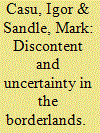

|
|
|
|
|
| Publication |
2014.
|
| Summary/Abstract |
This article examines reactions to de-Stalinisation in Soviet Moldavia between February 1956 and March 1957. The article is based on evidence from the archives of both the former Communist Party of Moldavia and the Moldavian KGB. It highlights the uncertainty there was at local levels because of the denunciation of Stalin. Local party reports demonstrate concern about the activities of religious activists, Western propaganda, nationalism and disaffected youth. The Hungarian revolution of 1956 caused the party to change tack, and to begin a clampdown. These reports highlight that Soviet rule had very shallow roots in Moldavia.
|
|
|
|
|
|
|
|
|
|
|
|
|
|
|
|
| 15 |
ID:
142829
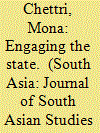

|
|
|
|
|
| Summary/Abstract |
In the eastern Himalayan borderland, state-led initiatives have led to the transformation of pre-existing patronage networks and placed ethnic identity at the core of regional politics. Based on ethnographic research in Sikkim, the paper illustrates the prolific rise of affirmative action politics and its relationship with ethnic identity, which has altered the social, political and religious landscape of Sikkim. The paper introduces a new approach to understanding borderlands as dynamic political spaces and contributes to a nuanced understanding of emerging forms of political agency and interaction on the peripheries of regional South Asia.
|
|
|
|
|
|
|
|
|
|
|
|
|
|
|
|
| 16 |
ID:
119921
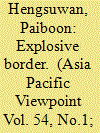

|
|
|
|
|
| Publication |
2013.
|
| Summary/Abstract |
The Salween borderlands can be conceptualised as spaces of exception where contradictory outcomes of state actions lead to state violence. The Burmese and Thai states have maintained their sovereign power and responded to economic regionalisation through violent practices in particular spaces. The political conflicts between the Burmese junta and ethnic minorities in the Salween borderlands have become war zones. The Burmese government in association with the Thai state and transnational dam investors has imposed the Salween dam projects on the Salween borderlands and people in the form of a terrorising state. The border people have experienced fear, danger and military violence, which has become part of the violence in everyday life. This paper provides an ethnographic study focused on specific events involving an explosion and death in a particular place and time on the Salween borderland. It shows the suffering of the border people in relation to sovereign power.
|
|
|
|
|
|
|
|
|
|
|
|
|
|
|
|
| 17 |
ID:
139438
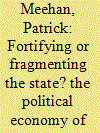

|
|
|
|
|
| Summary/Abstract |
Over the past twenty-five years, the government of Myanmar (Burma) has consolidated control over large parts of Shan State, neutralizing much of the threat posed by armed groups and strengthening its hold over revenue extraction. During this period Myanmar has retained its position as the world's second largest producer of illicit opium, much of which is converted into heroin within the country's borders. This article explores the relationship between state-building processes and the illicit opium/heroin economy in Shan State since 1988. The author has four aims. First, to reassess the theoretical assumptions that equate illicit economies with state fragility and demonstrate instead why illicit drug economies can become embedded in processes of conflict reduction and state consolidation. Second, to explain why establishing control over Shan State has become so important to the Myanmar government's state-building ambitions. Third, to analyze how the state's engagement with the drug trade has become a vital part of its attempts to consolidate control, in terms of financing military expansion and brokering deals with strongmen who are able to govern local populations. Finally, to assess how these strategies embody a form of “negotiated statehood” in which the state's growing control has been defined by attempts to manage, rather than monopolize, the means of coercion and extraction.
|
|
|
|
|
|
|
|
|
|
|
|
|
|
|
|
| 18 |
ID:
027945


|
|
|
|
|
| Publication |
London, Macmillan Press Ltd, 1972.
|
| Description |
xii, 290p.: maps, diagrams.Hbk
|
| Standard Number |
333039041
|
|
|
|
|
|
|
|
|
|
|
|
Copies: C:1/I:0,R:0,Q:0
Circulation
| Accession# | Call# | Current Location | Status | Policy | Location |
| 010896 | 944.0813/OUS 010896 | Main | On Shelf | General | |
|
|
|
|
| 19 |
ID:
147454
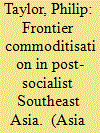

|
|
|
|
|
| Summary/Abstract |
The articles in this special issue examine processes of commoditisation in the frontiers of post-socialist Southeast Asia. Focusing on livelihood transformations in the borderlands of Laos, Cambodia, Vietnam and Thailand, the case studies reveal how relatively understudied actors, networks, flows and conjunctures initiate and shape commodity booms. Exploring how borderlanders engage, resist, cope with and survive commoditisation, the articles chart associated changes in values and in people's relations with each-other and their environment. This introductory article contextualises this new research and discusses the implications of the findings.
|
|
|
|
|
|
|
|
|
|
|
|
|
|
|
|
| 20 |
ID:
171934
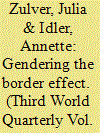

|
|
|
|
|
| Summary/Abstract |
In the Colombian–Venezuelan borderlands, the reconfiguration of armed group presence and mass migration create and reinforce conditions of high violence and risk. Against this backdrop, we ask: What are the gendered security implications of the double crisis in the borderlands? Based on fieldwork in four regions along the border, this article argues that the border effect is gendered; the very factors that coalesce to produce this effect exacerbate existing gendered power dynamics, particularly as these relate to gender-based violence. Accordingly, this article demonstrates the specific ways in which the border – as a facilitator, deterrent, magnet and/or disguise – reinforces experiences of gendered insecurity in this region. The article finishes by outlining the implications for other international borderland settings.
|
|
|
|
|
|
|
|
|
|
|
|
|
|
|
|
|
|
|
|
|